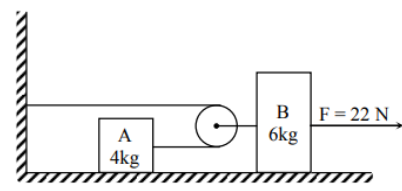
Answer
377.7k+ views
Hint:The point where the whole mass is assumed to be concentrated is known as the centre of mass and it is relative to an object or the system of objects and also the average position of all parts of the system, weighted according to their masses. The tension is nothing but the pulling force in the string and the direction of the string will be away from the load.
Complete step by step answer:
Given: Force exerted on the block $B$ when the blocks are at rest is $ = 22\,N$
$F = 22\,N$
Mass of block $A = 4\,kg$
Mass of block $A = 6\,kg$
We need to find acceleration of centre of mass of blocks $A$ and $B$ after $2s$ from the application of force
Let the tension in the string be $T$ , then;
$F - 2T = 6a$ ……….. $\left( 1 \right)$
$\Rightarrow T = 4 \times 2a$
$\Rightarrow T = 8a$ ……….. $\left( 2 \right)$
Substituting equation $\left( 2 \right)$ in equation $\left( 1 \right)$ we get
$F - 16a = 6a$
Therefore, $a = \dfrac{F}{{22}}$
Substituting the value of $F$ in above equation we get acceleration as
$a = 1\,m{s^{ - 2}}$
Then the acceleration of the centre of mass will be
${a_{cm}} = \dfrac{{\left( {6 \times acceleration{\text{ }}of{\text{ }}A} \right) + \left( {4 \times acceleration{\text{ }}of{\text{ B}}} \right)}}{{6 + 4}}$
${a_{cm}} = \dfrac{{\left( {6 \times 1} \right) + \left( {4 \times 2} \right)}}{{10}}$
\[\therefore {a_{cm}} = 1.4\,m{s^{ - 2}}\]
Hence, option A is correct.
Note:By using acceleration of the centre of mass we can find speed of centre of mass that is speed of centre of mass = acceleration $ \times $ time $ = 1.4 \times 2 = 2.8m{s^{ - 1}}$ because the acceleration is defined as rate of change of velocity. Is is a vector quantity and its $S.I$ unit is $m{s^{ - 2}}$.
Complete step by step answer:
Given: Force exerted on the block $B$ when the blocks are at rest is $ = 22\,N$
$F = 22\,N$
Mass of block $A = 4\,kg$
Mass of block $A = 6\,kg$
We need to find acceleration of centre of mass of blocks $A$ and $B$ after $2s$ from the application of force
Let the tension in the string be $T$ , then;
$F - 2T = 6a$ ……….. $\left( 1 \right)$
$\Rightarrow T = 4 \times 2a$
$\Rightarrow T = 8a$ ……….. $\left( 2 \right)$
Substituting equation $\left( 2 \right)$ in equation $\left( 1 \right)$ we get
$F - 16a = 6a$
Therefore, $a = \dfrac{F}{{22}}$
Substituting the value of $F$ in above equation we get acceleration as
$a = 1\,m{s^{ - 2}}$
Then the acceleration of the centre of mass will be
${a_{cm}} = \dfrac{{\left( {6 \times acceleration{\text{ }}of{\text{ }}A} \right) + \left( {4 \times acceleration{\text{ }}of{\text{ B}}} \right)}}{{6 + 4}}$
${a_{cm}} = \dfrac{{\left( {6 \times 1} \right) + \left( {4 \times 2} \right)}}{{10}}$
\[\therefore {a_{cm}} = 1.4\,m{s^{ - 2}}\]
Hence, option A is correct.
Note:By using acceleration of the centre of mass we can find speed of centre of mass that is speed of centre of mass = acceleration $ \times $ time $ = 1.4 \times 2 = 2.8m{s^{ - 1}}$ because the acceleration is defined as rate of change of velocity. Is is a vector quantity and its $S.I$ unit is $m{s^{ - 2}}$.
Recently Updated Pages
How many sigma and pi bonds are present in HCequiv class 11 chemistry CBSE

Mark and label the given geoinformation on the outline class 11 social science CBSE

When people say No pun intended what does that mea class 8 english CBSE

Name the states which share their boundary with Indias class 9 social science CBSE

Give an account of the Northern Plains of India class 9 social science CBSE

Change the following sentences into negative and interrogative class 10 english CBSE

Trending doubts
Fill the blanks with the suitable prepositions 1 The class 9 english CBSE

The Equation xxx + 2 is Satisfied when x is Equal to Class 10 Maths

In Indian rupees 1 trillion is equal to how many c class 8 maths CBSE

Which are the Top 10 Largest Countries of the World?

How do you graph the function fx 4x class 9 maths CBSE

Give 10 examples for herbs , shrubs , climbers , creepers

Difference Between Plant Cell and Animal Cell

Difference between Prokaryotic cell and Eukaryotic class 11 biology CBSE

Why is there a time difference of about 5 hours between class 10 social science CBSE




